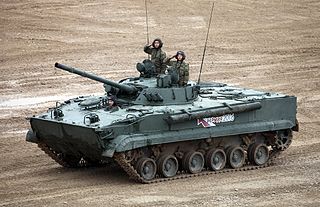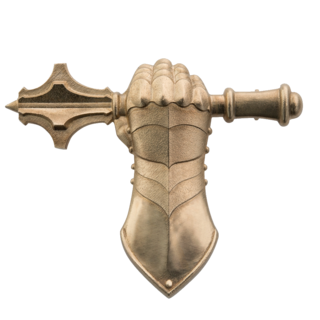
The BMP-3 is a Soviet and Russian infantry fighting vehicle, successor to the BMP-1 and BMP-2. The abbreviation BMP stands for Boevaya Mashina Pekhoty.

The Patria Pasi is a Finnish-made six-wheeled armoured personnel carrier (APC) originally designed for Finnish Defence Forces. The first variant was produced in 1983 and serial production began in 1984. It was designed to operate with ease of use, simple structure and low-cost maintenance. The basic appearance and configuration of the Pasi is similar to most other wheeled APCs. The XA-180 and XA-185 are fully amphibious, while other variants are not.

The MT-LB is a Soviet multi-purpose, fully amphibious, tracked armored fighting vehicle in use since the 1970s. It was also produced in Poland, where its YaMZ engine was replaced by a Polish 6-cylinder SW 680 diesel engine.

An armoured train or armored train is a railway train protected with heavy metal plating and which often includes railway wagons armed with artillery, machine guns, and autocannons. Some have also had ports used to fire small arms from the inside of the train, especially in earlier armoured trains. For the most part, they were used during the late 19th and the early 20th centuries, when they offered an innovative way to quickly move large amounts of firepower into a new location.

The Saxon is an armoured personnel carrier formerly used by the British Army and supplied in small numbers to various overseas organisations. It was developed by GKN Sankey from earlier projects, AT 100 IS and AT104, and was due to be replaced by the Future Rapid Effect System.

The BRDM-2 is an amphibious armoured scout car designed and developed in the Soviet Union. It was also known under the designations BTR-40PB, BTR-40P-2 and GAZ 41-08. This vehicle, like many other Soviet designs, has been exported extensively and is in use in at least 38 countries. It was intended to replace the older BRDM-1, and has improved amphibious capabilities and better armament compared to its predecessor.

The Land Forces are the land forces of the Polish Armed Forces. They currently contain some 110,000 active personnel and form many components of the European Union and NATO deployments around the world. Poland's recorded military history stretches back a millennium – since the 10th century. Poland's modern army was formed after Poland regained independence following World War I in 1918.

The BTR-3 is an eight-wheel drive armored personnel carrier developed in 2000 and 2001 by an international consortium. The companies involved in the project include the Kharkiv Morozov Machine Building Design Bureau of Ukraine, Adcom Systems of Abu-Dhabi, UAE, and the State Scientific Technical Centre of Artillery & Rifle Arms of Ukraine. Although somewhat similar in appearance to the Soviet BTR-80, the BTR-3U is an all-new production vehicle rather than an update of the existing in-service vehicle.

An improvised fighting vehicle is an ad hoc combat vehicle resulting from modified or upgraded civilian or military non-combat vehicle, often constructed and employed by civilian insurgents, terrorists, rebels, mobsters, guerrillas, partisans, drug cartels, criminal organizations or other forms of non-state militias and irregular armies. Such modifications usually consist of grafting improvised armour plating and fixed crew-served weapons such as heavy machine guns or antiaircraft autocannons mounted onto the back of a utility vehicle or pickup truck.

The Dozor-B is a four-wheeled Ukrainian armored car.

The Tigr is a Russian 4×4 multipurpose all-terrain infantry mobility vehicle manufactured by Military Industrial Company, first delivered to the Russian Army in 2006.

BMC Kirpi is a Turkish made Mine-Resistant Ambush Protected Vehicle manufactured by BMC. Kirpi provides significant protection against mine and ballistic threats. It combines standard and add-on armor providing protection against ballistic threats. Its V-shape underbody and monocoque allows it to protect the personnel inside from land mines and improvised explosive devices (IEDs).

KamAZ Typhoon is a family of Russian multi-functional, modular, armored mine-resistant ambush protected vehicles manufactured by the Russian truck builder KAMAZ. The Typhoon family is part of Russia's Typhoon program. As of 2021, the number of Typhoons in the Russian Armed Forces fleet was about 330 units of Typhoon-K.

The Armoured Troops are the armored corps of the Ukrainian Ground Forces, the main striking force of ground troops. They are used primarily in conjunction with mechanized forces in key areas and perform the following tasks:

During the Russian Civil War (1917–1922), Leon Trotsky, the Soviet People's Commissar of Defense from 1918 to 1925, used an armored train to travel between Red Army fronts and as a mobile command and propaganda center. In the course of the civil war, the train made 36 such trips to the fronts and traveled at least 75,000 miles (121,000 km). The train was in action against White and other anti-Bolshevik forces on 13 occasions during the civil war and suffered 15 casualties, and was itself awarded the Order of the Red Banner for its part in deflecting the advance on Petrograd by White general Nikolai Yudenich in October 1919.
The Russian armoured train Yenisei is an armoured train currently in use by Russia in their ongoing invasion of Ukraine in 2022. According to Ukrainian sources, Yenisei was constructed out of parts stolen from Ukrainian Railways in the Kharkiv region. It is named after the Yenisey river.

Pro-democratic and pro-Ukrainian partisan movements have emerged in Russia following the Russian invasion of Ukraine, a major escalation of the Russo-Ukrainian War. These resistance movements act against the authoritarian government of Vladimir Putin in Russia, as well as against civilian supporters of these authorities and the armed forces, with the aim of stopping the war.
The Russian armoured train Volga is an armoured train currently in use by Russia in its ongoing invasion of Ukraine in 2022. Unlike its sister train Yenisei, which is built primarily for logistics and refugee ferrying, Volga is primarily used for engineering, reconnaissance, mine clearance, restoration of damaged railway tracks, and escorting cargo within the Ukrainian combat zones.
The Russian armoured train Amur is an armoured train currently in use by Russia in its ongoing invasion of Ukraine in 2022. Unlike the newer trains Yenisei and Volga, Amur was already built long before the Russian invasion of Ukraine. Both Amur and its sister train, Baikal, were reactivated back in 2016, originally for rear-line logistical purposes.















